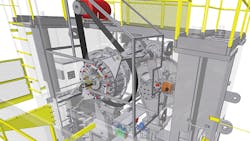Mark Twain was famously quoted that reports of his death had been “an exaggeration.” More than a century later, in 2008, Apple co-founder Steve Jobs said much the same thing in his own Mark Twain moment when Bloomberg erroneously reported Jobs’ passing.
I’ve noticed that a similar “premature death” seems to have occurred in the manufacturing industry, where all of the headlines and hype are being grabbed by 3D printing (additive manufacturing), while machining’s robust growth has gone mostly unnoticed.
Certainly when the first commercial 3D printer went on sale in 1987, experts said it signified the beginning of the end for machining; that parts would soon be popping out of 3D printers faster than a cup of Earl Grey tea from a replicator on the Starship Enterprise.
And while additive manufacturing—especially metal additive manufacturing—continues to make significant revisions to the book of what’s possible, I can tell you emphatically that machining isn’t going away anytime soon.
Machining’s Double Digit Growth
Don’t take my word for it—just follow the numbers that tell the story of a machine tool industry flourishing right now. According to the Association for Manufacturing Technology, U.S. manufacturing technology orders continued a double-digit percentage, month-after-month, rise, with machine tool orders totaling $2.13 billion, up 26% compared to the same five-month period in 2017.
As a CNC machining service provider, we at Protolabs have also seen double-digit percentage growth, to the point that we’re adding capacity in the form of another machining plant. This demand stems from how machining automation (more on that in a minute) and quick-turn part production are enabling engineers, designers, and procurement teams to get parts fast, develop products faster, and produce mass customization to meet customer needs, whether they are launching products to market or launching rockets to space.
Still another example is what is happening with machining equipment suppliers. Haas Automation, one of our suppliers of lathes and milling centers, reports that orders are up everywhere—Europe, China, the Pacific Rim, South America. It seems everyone is buying machine tools.
Haas isn’t the only one. Charlotte-based Okuma America Corporation claims that right now is potentially the hottest market they’ve ever experienced. Shops are looking for every opportunity to become more efficient, from new machine tools and processes to new types of workholding and cutting-tool technology. Simply stated, the machine tool industry is thriving.
Machining: Automate or Else
Of course, one of the biggest drivers behind machining’s impressive growth is automation. Where Haas introduced its first automatic parts loader in 2000 to lukewarm applause, today its automation lineup is booming. So, too, is Okuma’s, and this automation goes well beyond the stereotypical robotically loaded machine tool. These and other machine manufacturers are providing the types of automation technology that makes machining more efficient and requires less manpower—quick-change tooling, multi-tasking machines, software that integrates shop floor processes with corporate enterprise resource planning systems (ERP), and more. As a source from Okuma said, it’s anything that makes a manufacturer more flexible and responsive, in essence, giving that manufacturer the ability to compete in today’s high-mix, low-volume production environment.
Now, that said, I do need to acknowledge that this is the environment that 3D printers thrive in. Because designers can go from CAD model to printed part in days or even hours, it has long been understood that prototypes and low-volume production can often be produced far more cost-effectively than with traditional manufacturing methods. There’s no tooling investment, downtime because of machine setup is minimal, and design freedom is assured. By comparison, shops able to deliver complex machined parts by tomorrow or the next day were basically unheard of in the early days of 3D printing. As a result, the hype emerged over the “rapid prototyping” made possible by additive manufacturing technology. But much has changed since those days.
Expectations? I Want it Now
Yes, 3D printing has continued down its path of solid growth; we’ve certainly seen 3D printing’s progress and stunning technological developments over the past few years at Protolabs, as additive capabilities continue to advance. But machining is still here and continues to thrive right alongside 3D printing technologies, thanks to machine tools that are far faster, more accurate, and less expensive (relative to 1987 dollars) than they were three decades ago. Plus, the tooling and software that supports them has made dramatic improvements as well. Machine controls are easier to operate, programming systems more advanced, and cutting tools remove metal more quickly than previous generations of machining equipment.
And in an interesting twist of fate, machining and 3D printing often work together in some cases to produce end-use parts. Take metal 3D printing, for example. Once metal parts are 3D printed through a process like direct metal laser sintering, CNC machining is essential in secondary operations that fine-tune features and holes on parts requiring higher levels of finishing.
People, Not 3D Printers, the Most Valuable Assets at On-Demand Manufacturer
When all of these capabilities are factored in, automation technology has helped CNC machining flourish. Due in part to the scarcity of skilled machinists and demand for rapid manufacturing services, digital manufacturers are embracing automation like never before. Speaking for myself and others, it’s simply a great time to be in manufacturing.
Protolabs, for example, has developed proprietary technology that turns CAD models into machined parts and products within the same time frame as those made on a 3D printer. We’ve also extended that automation into other traditional manufacturing processes like injection molding and sheet metal fabrication. It’s a reinvention of traditional manufacturing, which is essential to keep pace in an on-demand environment.
Product developers and engineers along with the companies they work for have grown to expect near-instant gratification, and why not? Those who design and purchase parts want them in their exact specifications, exact material, and exact quantity, and they want them quickly. So do their customers. Product development cycles are increasingly compressed. Trends like mass customization and accelerated speed to market are legitimate challenges facing companies every day. The takeaway is clear: Automated, high-tech machining is not going away, but traditional machine shops very well could be.
Manufacturing: The Road Ahead
Casualties aside, this is all good news for any industry using large quantities of machined parts, including aerospace, medical, energy, consumer products—all can and do turn to one-stop, quick-turn, web-enabled shops like ours, secure in the knowledge that parts will arrive within a few days.
To fully leverage these technologies, however, those who design and purchase machined parts must learn to think differently. They must embrace the digitalization of traditional processes like machining. 3D CAD models rather than 2D drawings must become the reference document for every aspect of the product’s life cycle. Digital metadata must become the standard by which machining requirements are conveyed to tomorrow’s manufacturers.
These “low friction” digital transactions have long been the norm for 3D printing, but are rapidly becoming the norm for CNC machining as well, at least for manufacturers that are following a digital manufacturing model. The result is that it’s now possible to achieve the low-volume customization that was previously unaffordable because of the cost-prohibitive overhead that comes with establishment of supply chains able to handle small runs of machined parts.
And the key for those of us in the midst of this digital manufacturing revolution? We must continue to adopt new technologies and embrace this ever-changing digital landscape.
About the Author
Judy Carmein
Global Product Manager, CNC Machining and Sheet Metal Fabrication
Judy Carmein is the global product manager for CNC machining and sheet metal fabrication at Protolabs. Carmein previously worked as a project manager both at Protolabs and FAAC Inc. Prior to working in management, she spent several years as a software developer in the custom motion control and 3D printing businesses. Carmein holds B.S. and M.S. degrees in Mechanical Engineering.



